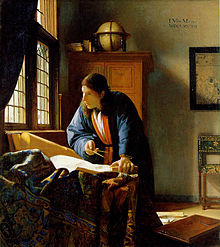This is an old revision of this page, as edited by 71.92.162.253 (talk) at 01:32, 8 February 2012. The present address (URL) is a permanent link to this revision, which may differ significantly from the current revision.
Revision as of 01:32, 8 February 2012 by 71.92.162.253 (talk)(diff) ← Previous revision | Latest revision (diff) | Newer revision → (diff)Template:Infobox dawn of microscopy in the 16th century</ref> They were found to be of _id%5B%5D=39211 |title=Secret of Antony van Leeuwenhoek? |journal=Nauka i Zhizn (Science and Life) |volume=09-1980 |pages=80–2 }}</ref>
Religious interpretations of his discoveries
Van Leeuwenhoek was a Dutch Reformed Calvinist. He often referred with reverence to the wonders God designed in making creatures great and small. He believed that his amazing discoveries were merely further proof of the great wonder of God's creation.

Van Leeuwenhoek's discovery that smaller organisms procreate similarly to larger organisms challenged the contemporary belief, generally held by the 17th-century scientific community, that such organisms generated spontaneously. The position of the Church on the exact nature of the spontaneous generation of smaller organisms was ambivalent.
Possible Vermeer connection
Van Leeuwenhoek was a contemporary of another famous Delft citizen, painter Johannes Vermeer, who was baptized just four days earlier. It has been suggested that he is the man portrayed in two of Vermeer's paintings of the late 1660s, The Astronomer and The Geographer. However, others argue that there appears to be little physical similarity. Because they were both relatively important men in a city with only 24,000 inhabitants, it is likely that they were at least acquaintances. Also, it is known that Van Leeuwenhoek acted as the executor of the will when the painter died in 1675.
In A Short History of Nearly Everything (p. 236) Bill Bryson alludes to rumors that Vermeer's mastery of light and perspective came from use of a camera obscura produced by Van Leeuwenhoek. This is one of the examples of the controversial Hockney–Falco thesis, which claims that some of the Old Masters used optical aids to produce their masterpieces.
See also
Footnotes
- "The religious affiliation of Biologist A. van Leeuwenhoek". Adherents.com. 2005-07-08. Retrieved 2010-06-13.
- "The Religion of Antony van Leeuwenhoek". 2006. Retrieved 2006-04-23.
- A. Schierbeek, PhD, Editor-in-Chief of the Collected Letters of A. v. Leeuwenhoek, Formerly Lecturer in the History of Biology in the University of Leyden, Measuring the Invisible World: The Life and Works of Antoni van Leeuwenhoek F R S, Abelard-Schuman (London and New York, 1959), QH 31 L55 S3, LC 59-13233. This book (223 pp.) contains excerpts of Leeuwenhoek’s letters and focuses on his priority in several new branches of science, but makes several important references to his spiritual life and motivation.
- Van Berkel, K. (February 24, 1996). Vermeer, Van Leeuwenhoek en De Astronoom. Vrij Nederland (Dutch magazine), p. 62–67.
Bibliography
- Alma Smith Payne, The Cleere Observer: A biography of Antoni van Leeuwenhoek, Macmillan, London, 1970.
- Dobell, C. (1932, 1960) Anthony van Leeuwenhoek and his little animals.
External links
- Leeuwenhoek's letters to the Royal Society
- Lens on Leeuwenhoek (site on Leeuwenhoek's life and observations)
- Vermeer connection website
- University of California, Berkeley article on Van Leeuwenhoek
- Works by Antoni van Leeuwenhoek at Project Gutenberg
- Retrospective paper on the Leeuwenhoek research by Brian J. Ford.
- Images seen through a van Leeuwenhoek microscope by Brian J. Ford.
- Instructions on making a Van Leeuwenhoek Microscope Replica by Alan Shinn
- Antoni von Leeuwenhoek Centraal (blog on Leeuwenhoek)